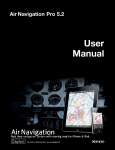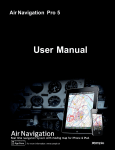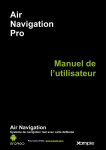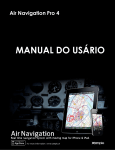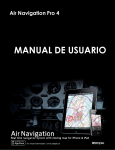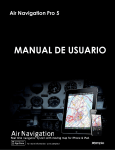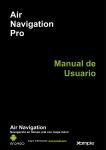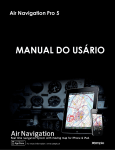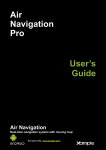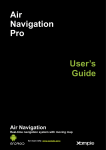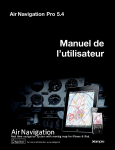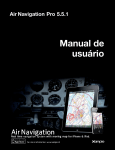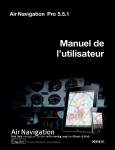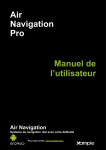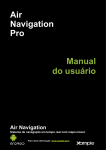Download Air Navigation Pro 5 User Manual
Transcript
Air Navigation Pro iOS Air Navigation Pro 5 User Manual Av a i l a bl e on t h e 1 Air Navigation Pro iOS The information in this document is subject to change without notice and does not represent a commitment on the part of Xample Ltd. The software described by this document is subject to a License Agreement and may not be copied to other media. All product and company names are TM or ® trademarks of their respective owners. Document authored by: Johann Huguenin and Flavien Volken Product Version: 5.1 (06/2012) Document version: 5.1 (06/2012) Special thanks to our Beta testers, partners and users who where invaluable in making this a better product. Switzerland Xample LLC Coteau des Ifs 41b 1400 Cheseaux-Noréaz Switzerland http://www.xample.aero DON’T FORGET TO CHECK FOR NEW UPDATES AT: http://www.facebook.com/AirNavNews REMEMBER TO VISIT OUR YOUTUBE CHANNEL FOR TUTORIALS AT: http://www.youtube.com/XampleAirNav 2 Air Navigation Pro iOS Contents 1. Introduction Minimum requirement . . . . . . . . . . . . . . . . . . . . . . . . . . . . . . . . . . . . . . . . . . . . . . . . . . . . 5 2. User interface Interface on iPad . . . . . . . . . . . . . . . . . . . . . . . . . . . . . . . . . . . . . . . . . . . . . . . . . . . . . . . . . 7 Interface on iPhone/iPod Touch . . . . . . . . . . . . . . . . . . . . . . . . . . . . . . . . . . . . . . . . . . . . 8 Buttons in the toolbar . . . . . . . . . . . . . . . . . . . . . . . . . . . . . . . . . . . . . . . . . . . . . . . . . . . . 9 3. Installation Installing maps and charts . . . . . . . . . . . . . . . . . . . . . . . . . . . . . . . . . . . . . . . . . . . . . . . 14 Installing VFR approach charts for Germany . . . . . . . . . . . . . . . . . . . . . . . . . . . . . . . 17 Restore purchased maps and charts . . . . . . . . . . . . . . . . . . . . . . . . . . . . . . . . . . . . . . 17 4. Moving map Real-time usage . . . . . . . . . . . . . . . . . . . . . . . . . . . . . . . . . . . . . . . . . . . . . . . . . . . . . . . . 18 Select a waypoint from the database . . . . . . . . . . . . . . . . . . . . . . . . . . . . . . . . . . . . . . . 20 Route planning . . . . . . . . . . . . . . . . . . . . . . . . . . . . . . . . . . . . . . . . . . . . . . . . . . . . . . . . . 21 Adding an Aircraft profile . . . . . . . . . . . . . . . . . . . . . . . . . . . . . . . . . . . . . . . . . . . . . . . . 23 Map Options menu . . . . . . . . . . . . . . . . . . . . . . . . . . . . . . . . . . . . . . . . . . . . . . . . . . . . . . 24 5. Instruments HSI , VOR , ADF , Compass , Altimeter , Groundspeed . . . . . . . . . . . . . . . . . . . . 28-34 Flight information . . . . . . . . . . . . . . . . . . . . . . . . . . . . . . . . . . . . . . . . . . . . . . . . . . . . . 35 6. Tools Flight Time . . . . . . . . . . . . . . . . . . . . . . . . . . . . . . . . . . . . . . . . . . . . . . . . . . . . . . . . . . . . 36 Record a Flight . . . . . . . . . . . . . . . . . . . . . . . . . . . . . . . . . . . . . . . . . . . . . . . . . . . . . . . . 37 Logbook . . . . . . . . . . . . . . . . . . . . . . . . . . . . . . . . . . . . . . . . . . . . . . . . . . . . . . . . . . . . . . 38 Weather . . . . . . . . . . . . . . . . . . . . . . . . . . . . . . . . . . . . . . . . . . . . . . . . . . . . . . . . . . . . . . 39 Document browser . . . . . . . . . . . . . . . . . . . . . . . . . . . . . . . . . . . . . . . . . . . . . . . . . . . . 40 Sensors . . . . . . . . . . . . . . . . . . . . . . . . . . . . . . . . . . . . . . . . . . . . . . . . . . . . . . . . . . . . . . 42 Screen lock and notebook . . . . . . . . . . . . . . . . . . . . . . . . . . . . . . . . . . . . . . . . . . . . . . 43 Connecting the X-Plane plugin . . . . . . . . . . . . . . . . . . . . . . . . . . . . . . . . . . . . . . . . . . 44 Connecting the MS FSX plugin . . . . . . . . . . . . . . . . . . . . . . . . . . . . . . . . . . . . . . . . . . . 46 Approach charts . . . . . . . . . . . . . . . . . . . . . . . . . . . . . . . . . . . . . . . . . . . . . . . . . . . . . . . 60 7. EFIS module Features . . . . . . . . . . . . . . . . . . . . . . . . . . . . . . . . . . . . . . . . . . . . . . . . . . . . . . . . . . . . . . 47 3D / 2D Terrain awareness . . . . . . . . . . . . . . . . . . . . . . . . . . . . . . . . . . . . . . . . . . . . . . 49 8. Third-party services GoVFR . . . . . . . . . . . . . . . . . . . . . . . . . . . . . . . . . . . . . . . . . . . . . . . . . . . . . . . . . . . . . . . 50 9. Advanced features (importing/exporting) Embedded Webserver . . . . . . . . . . . . . . . . . . . . . . . . . . . . . . . . . . . . . . . . . . . . . . . . . . 52 WebDAV server . . . . . . . . . . . . . . . . . . . . . . . . . . . . . . . . . . . . . . . . . . . . . . . . . . . . . . . . 55 Attach a PDF document . . . . . . . . . . . . . . . . . . . . . . . . . . . . . . . . . . . . . . . . . . . . . . . . . 59 Waypoints file format . . . . . . . . . . . . . . . . . . . . . . . . . . . . . . . . . . . . . . . . . . . . . . . . . . 61 Airspaces file format . . . . . . . . . . . . . . . . . . . . . . . . . . . . . . . . . . . . . . . . . . . . . . . . . . . 64 3 Air Navigation Pro iOS Introduction Thank you for your interest in Air Navigation. Air Navigation was developed with General Aviation in mind, however it was quickly adopted by pilots of various flying vehicles including for example paragliders, gliders, ultra light, single or multiengine airplanes, helicopters and even hot air balloons. Air Navigation is an affordable, yet powerful flight planning and real-time navigation application. With version 4, the application user interface was overhauled to make it easier to use and add various new features. We hope you’ll enjoy the product as much as we enjoyed working on it. About this document This document is not intended to be a complete user manual. A complete user manual covering all the functionalities of Air Navigation will be available separately. In this document you will find references to 3 versions of Air Navigation (Free, Standard and Pro), however, this document will focus on Air Navigation Pro 5.0. About Air Navigation Air Navigation is a real time distributed in 3 versions : navigation and flight planning application. It is - Air Navigation Free - Internal database with more than 100 000 waypoints, airports and related information; - Navigation instruments (HSI, CDI, ADF). - Air Navigation Standard - Moving map with direct to waypoint capability; - Access to free of charge, open source maps, downloadable from within the application; - Internal database with more than 100 000 waypoints, airports and related information; - Internal database with airspaces information (not all countries available). - Logbook (manual); - Navigation instruments (HSI, CDI, ADF). 4 Air Navigation Pro iOS - Air Navigation Pro - Moving map with multi leg flight planning or direct to waypoint capability; - Access to commercial aviation charts (as in-app purchases) for Europe, USA, Australia, New-Zealand (check our website for available countries); - Support for geo referenced approach charts (not all countries available, check our website for mo r e information); - Access to free of charge, open source maps, downloadable from within the application; - Internal database with more than 100 000 waypoints, airports and related information; - Internal database with airspaces information (not all countries available); - Logbook (automatic); - Support for elevation data, see terrain in front of airplane or while planning legs; - Support for 3D data of Synthetic Vision (EFIS module); - Navigation instruments (HSI, CDI, ADF). Minimum requirement Air Navigation Pro 5 will run on : - An iPhone, iPod Touch or iPad; iOS operating system version 4 or higher; 200 MB of available space for the application and database; approximately 350 MB of available space for each chart of the size of a country like France or Germany; - A GPS module is mandatory for real time navigation. iPhone 3G/3GS/4 and iPad 1 or 2 with 3G capabilities have an integrated GPS. iPod Touch and iPad Wifi only require an external GPS module. Example of external GPS modules are : - TOM TOM car kit for iPhone or iPod Touch; - GNS 5870 MFi Bluetooth; - Bad Elf 66 channels. The application will run on a 3G iPhone. For better performances an iPhone 3GS or 4 is recommended. 5 Air Navigation Pro iOS Disclaimer Before using this software, you must read and conditions. and agree with the following terms This software is not intended to replace a certified navigation device! We do not guarantee the accuracy and comprehensiveness of the information provided. The embedded navigation database is provided for informational purpose only. It may not be complete and may contain erroneous data. You should always use official aeronautical documentation (AIP) when preparing and performing a flight. You should always use certified navigation devices when performing a flight. This software is provided ‘as-is’, without any express or implied warranty. In no event will the authors or third party data providers be held liable for any damages arising from the use of this software. YOUR USE OF THIS REAL TIME ROUTE GUIDANCE APPLICATION IS AT YOUR SOLE RISK. LOCATION DATA MAY NOT BE ACCURATE. 6 Air Navigation Pro iOS User interface On iPad the screen is divided to display the selected route and an instrument of your choice on the left side. The moving map is on the right side together with the data bar at the bottom. An optional terrain profile view can be displayed at the bottom. The moving map can be set to full screen and it this case, the route and the instrument are hidden but still accessible from the instrument button in the top toolbar. Other modules, functionalities and settings can be accessed from the top toolbar. Air Navigation Pro 5 on iPad Toolbar Current Route Moving map Instrument Terrain profile 7 Air Navigation Pro iOS Air Navigation Pro 5 on iPhone/iPod Touch On iPhone one module can be displayed at a time. By default, the moving map is displayed at launch time. Other modules can be displayed by pressing the corresponding tab buttons at the bottom of the screen. On iPhone the toolbar is hidden by default and «screwdriver» button on the left side to display it. Other modules and settings can in the bottom right corner. be you accessed in the must press the «Configuration» tab Toolbar (normally hidden) Moving map Terrain profile Tab bar 8 Air Navigation Pro iOS Buttons in the Toolbar On iPhone, this button toggles the moving map data bar visibility on/off. On iPad, this button toggles between SPLIT screen and fullscreen mode. The split screen shows two of the selected instruments together with the moving map. This instruments/route can be selected from the “Instruments Layout” menu in «Configuration» button at the top-right corner of the toolbar. For more information please refer to «Configuration» icon on next page. This button will run the EFIS module. You will first need to download the 3D data from the “Map Store” menu. On the iPhone, you will find this instrument on the «Configuration» tab at the bottom right corner. “Map Options” displays the map settings module. In the map settings you can configure what will be displayed on the map and how. Please refer to the chapter “Map Options” for details. The following are the available options on this menu: • Control the screen brightness; • Show/hide the map background (the installed charts/maps); • Show/hide the terrain elevation graph; • Enable the Terrain awareness 3D/2D; • Show/hide symbols of weather conditions (VMC, IMC); • Setup the airspaces filter and display modes; • Setup the waypoints filter; • Enable, disable the extended track and bearing line widgets; • Enable Maps/Charts and choose which map will be displayed on top o f t h e o t h e r s ; • Choose background color (for where there´s no map). Toggles between flight mode and edit mode. When edit mode is turned on, a yellow-black bar at the top of the screen indicates it is active. On the edit mode it is possible to tap waypoints on the map to add/ remove them to/from a current route. On “Edit” mode, you can freely navigate the EFIS module. 9 Air Navigation Pro iOS Displays the waypoint database where it is possible to search for a particular waypoint or list nearby waypoints, sorted by distance. Displays the list of saved routes. Tapping on a route from the list will set this route as current, display the legs in the «Route» module and display the route in the moving map as a magentacolor vector. Selects the nearest airfield direct to waypoint. from your current location as a Clears the current selected route or direct to. Press this button when you want to set the map to «free flight» mode and/or when you want to start a new blank route. This tool works also when having to hide an approach chart. Displays the current flight logbook entry. On iPhone, this module is reachable from the tabs at the bottom and has a slightly different icon. Displays the instruments list. On iPhone/iPod Touch, the instruments list is reachable from the «Configuration» tab at the bottom right corner. Displays a list of weather stations and latest METAR/TAF information in a decoded format. You can add stations of your choice by entering an identifier in the search field on top and press return. On iPhone/iPod Touch, this module is reachable from the «Configuration» tab at the bottom right corner. Displays a list of documents (PDFs) associated to an airfield. Pressing a document will display its content in fullscreen mode. You will also use this tool to create an Aircraft profile. On iPhone/iPod Touch, this module is reachable from the «Configuration» tab at the bottom right corner. 10 Air Navigation Pro iOS Displays the «Tools» list where you can find additional utilities. On iPhone/iPod Touch, the tools are reachable from the «Configuration» tab at the bottom right corner. The following are the available options on this menu: • GoVFR tool. Please refer to the “Third Party Services” chapter on this manual; • Custom Waypoint Editor. Please refer to the “Create waypoints” chapter on this manual; • Logbook. Please refer to the “Logbook” chapter on this manual; • Recorded Flights. You can reproduce your flights live on this option. Refer to “Record a Flight” chapter on this manual; • Sensors. Please refer to the “Sensors” chapter on this manual. Displays the «Settings» module where you can fine tune the application behavior and customize units and other settings. We can also find the «MapStore» module within this button, from where you can download both free and commercial maps/charts/data. When using the Waypoints database search engine, you can enable/ disable the countries displayed to make the search easier. This button also displays the “Instrument Layout” menu, where the instruments are reordered on top of the list in order to appear in the SPLITTED screen when using an iPad. In this case, only the first two will show together with the moving map. On an iPhone/iPod Touch, the “Instruments Layout” menu will reorder the first 4 instruments to show them in the BOTTOM TAB BAR. All the mentioned modules and settings are reachable from the «Configuration» tab at the bottom right corner on an iPhone/ iPod Touch. 11 Air Navigation Pro iOS The following are the available «Settings»: • Units. Gives the possibility to change the units of the displayed values: - Distance & speed: NM & KTS, M & Mph, km & km/h. - Runway lengths: meters, feet. - Altitude: meters, feet. - Pressure (AHRS g mini): hPa, inHg. - Coordinates: DD:MM:SS, decimal, DD:MM.mm. - Fuel: liters, gallons, pounds, kilograms. - Logbook time: HH:MM, decimal. • Map. Blocks/allows map rotation. When “Auto approach charts” option is ON, the approach plate will show up on the moving map when the desired Airport is the next waypoint. Note that in order to use this option, you will first need to purchase the “VFR/IFR” approach charts from the Map Store (not all countries available). Please refer to the next chapter for more info. “TRK/Bearing” option will allow you choose from showing True North or Magnetic North when creating a Route/displaying next waypoint. When “Hidden points selectable” option is ON, the user can still select a waypoint if it`s hidden. • Instruments. You can choose from displaying the True/Magnetic North when using the Compass. When “Adjust Nav 1 to map leg” is ON, the instrument will automatically be configured to the NEXT waypoint on the map. Remember that as it`s “Nav 1” it will only affect to the FIRST instrument of the list showing under “Instrument Layout” menu. You can also choose from ADJUSTING the OBS when using the ADF, VOR and HSI. This will automatically align the arrow/CDI of the instrument in direction of the configured waypoint. • Network. This will show, when enabled, the IP addesses to connect the Mac/PC with the E mbedded WebServer or the W ebDAV server. You also have the option for enabling “GSM download”, when using 3G/4G network to download charts/data or using the METAF/TAF feature. 12 Air Navigation Pro iOS • Misc. The user can RAW the METAR/TAF information, enable the option for recording a flight (refer to the “Record a flight” chapter) and have the possibility to run the app in the background on the iPad, if having to temporarily use another app or change settings outside Air Navigation Pro. If Air Nav remains in the background for more than 10 minutes, it will automatically close so as to save energy. “Alternate speed/course” option forces Air Nav compute the data in “time deltas” and not continuously. This will help when the GPS signal is weak and breaks off intermittently. The “Automatic logbook” option will complete the Block-OFF/Block-ON times and the Take-OFF/Landing times automatically. Please refer to the “Logbook” chapter in this manual for details. “Share GPS via Bluetooth” will let PAIR the device with another one of the same nature (for example an iPad with an iPod Touch) and share the GPS signal. Both devices must have Air Navigation running. For more information, please refer to the “Sensors” chapter in this manual. • Disclaimer. Disables the “Disclaimer” message at the start of the app. • Default. Reverts to factory settings, WITHOUT deleting or modifying existing waypoints, routes, flights or logbook. This last option might help in case Air Navigation Pro is not working properly. • Spinball. This option will only appear in the “Settings” section of the iPhone/iPod Touch. There is not such a feature on an iPad. To calibrate the spinball, you have to position your iPhone/iPod Touch on a flat surface. 13 Air Navigation Pro iOS Installation Application Settings After installation of the application, at first launch, the system will ask for authorization to access location data (GPS). You should allow GPS access to Air Navigation otherwise realtime navigation functionalities will not work properly. After launching Air Navigation for the first time, the map should be centered to your current location. The application has an internal waypoints database and you should see waypoints in the vicinity on the map. Please note that NO map i n t h e background is installed with the application. You can install a map from various free of charge or commercial sources from the «MapStore» module located in the «Configuration» button on iPad and in the «Configuration» tab on iPhone/iPod Touch. You can find more information on how to install maps/ charts in the next chapter. Should you wish to change length, from the «Settings» panel. speed or altitude units, you can do so Installing maps and charts Commercial charts screenshots: http://www.facebook.com/AirNavShots For Reinstalling purchased maps please refer to the chapter below current. Free of charge open source maps, charts from the public domain and commercial charts can be installed to be used as the background image of the moving map module. Maps/charts are downloaded from our servers from within the application. They are stored in the iPhone/iPad memory and do not require an internet connection while flying. To browse the available maps/charts catalog, choose «MapStore» from the «Configuration» menu (top right button) on iPad or from the «Configuration» tab on iPhone. Before you attempt to download a map you should check that : - Your iPhone/iPod/iPad is connected to a functional Wifi network - Bluetooth is turned OFF on your device, as it can disturb the Wifi network, sometimes leading to download failure. 14 Air Navigation Pro iOS The map store module has 2 sections. The top section is to manage installed product. In the installed products module, it is possible to display a list of maps/charts installed on your device. It is also possible to reinstall a product in the list if it is not functioning properly. This is also where you can delete a product or parts of a product that is outdated for example. The «Download Queue» module lists current and pending downloads. This module is typically used to monitor download progression of a map/chart It is possible to reorder the downloads or to remove an item from the download list. The «Download products» section is a catalog of available maps/charts. You can browse the products and get information about them such as : - Source/Provider - Country or Area - Product size - Product price (if not-free) - Included packages: Most products contains only 1 package, however, some products may be composed of 2 or more sub packages. It is possible to choose which packages will be installed or not. For example, the USA Sectional charts are sold as one product but contains more than 50 sectional charts. Should you wish to fly only the east coast of the United-States, you can install only the relevant charts. 15 Air Navigation Pro iOS It is possible to install the other package later by browsing to the product detail and press the corresponding line in the «installed packages» section. Installed packages appear colored : - Green : installed and up to date; - Orange : installed but a newer available for download. version is Uninstalled packages appear in white. When a particular package appears in orange, it means that an update is available. The reason could be : - A chart update, that is part of your subscription is available; - We found an issue with the chart and we released a fixed version. In Air Navigation 5 with added support for a new map/chart file format of higher quality. The old map packages are displayed with the «Air Navigation 2.x - 3.x map group» tag in the «Installed products» module. The older packages are not part of iTunes backup. The newer packages are now part of the iTunes backup and should be restored with the application if you reinstall your device. 16 Air Navigation Pro iOS Installing VFR approach charts for Germany Due to licensing terms, the VFR approach charts for Germany are not (yet) sold through the AppStore facility. You can purchase the approach charts package from our web store, hosted at Kagi at this url : http://store.kagi.com/cgi-bin/store.cgi?storeID=HEC_LIVE&& In the confirmation email, you will receive a license code and a clickable link. The clickable link will install the product automatically in Air Navigation. Should you wish to install it manually, you can input the license code in the «Restore purchases» -> «Input code» module of the «MapStore module» (see next chapter for details). Reinstalling previously purchased maps and charts In Air Navigation 4 we added a «Restore purchases» button on the top right corner of the «MapStore» module. This is useful if you reinstalled the application and to reinstall the maps from the internet. Pressing this button will ask you if you want to : - Restore purchased charts from your iTunes account : In this case a list of purchases found on your iTunes account will be displayed. You can then press on a particular chart to reinstall it for free. This will also work if you install Air Navigation on a new iPhone or iPad, in this case you should use the same iTunes account as your other device. - Input a license code : this option can be used for product that where sold with a license code, such as the VFR approach charts for Germany. 17 Air Navigation Pro iOS The moving map Real Time usage The moving map is the main instrument of Air Navigation. It is used for real time navigation as well as route planning or creation of user waypoints. In Air Navigation 4, you can create a route/waypoint d i r e c t l y from the moving map. It is possible to add intermediate waypoints to your current route during a flight (to avoid bad weather conditions for example) By default, the moving map is centered on your current location, north oriented. By pressing to the symbol in the top left corner, you can toggle between : North oriented, current location in the center of the s creen, moving Track oriented, current location at 1/3 the bottom of the screen, rotating to match current track, moving Touching and moving the map will switch to panned mode. In this case the map will be moved to the location of your choice, north oriented. It will not move to follow your current location, instead, the aircraft symbol will move on the map, possibly leave the screen area. You can center the map again and restore map movements by pressing once on the symbol in the top left corner. 18 Air Navigation Pro iOS Touching an area of interest on the map information. Touchable items are : will reveal a popup with useful - Waypoints : elevation, type, full name for Navaids and their frequency, for Airports you will get runway and frequency information. - Airspace : lower and upper limits, name, class and additional information - METAR/TAF stations : Weather information of an Airport. You enable them in the «Map Otions» menu. On iPad, pressing outside the popup will hide it, on iPhone you have to press the close button in the top right corner of the popup. When in flight mode (default), pressing on the name of the waypoint will ask you if you want to select this waypoint and affect it to an instrument or direct to t h e point in the moving map. 19 Air Navigation Pro iOS Selecting a waypoint from the database By pressing on this button at the top toolbar on an iPad or within the toolbar in an iPhone/iPod Touch (accessible from the “screwdriver” button), you can have access to the waypoints database. You can search by country or use the “search” field to go directly to the waypoint you are looking for. It is possible to search by “name”, “ID”, “place”. Once you found the desired waypoint, you can directly press on it to select it as a “direct to” or adjust it to one of the instruments (HSI, VOR, ADF); or you can press on the blue disclosure button on the right side and check the information about it such as name, city, frequency (for Navaids), runway and contact frequency info (for Airfields) and you can “jump” on the map where that waypoint is located by selecting “Show on map” button. 20 Air Navigation Pro iOS The data bar at the bottom of the moving map will display real time information such as next waypoint information (identifier, name, bearing, distance and estimated time), current speed as reported by the GPS (ground speed), track, altitude as reported by the GPS, height over ground (if the elevation data for your area is installed), quality of the GPS signal. For real time navigation, the quality of the GPS signal is required to be a green or yellow symbol. A red or orange symbol will only show an approximate location and will not report speed nor track information. For better results, you should place your device near a window, with a direct view of the sky, Do not hold the iPad with the hand covering the GPS antenna (black area on the top of the iPad). If you are flying with a full metal airplane or your airplane is equipped with anti ice windshield, the internal iPhone/iPad GPS may be a bit weak and you may need an external GPS module. Route planning By default, the moving map is in «flight mode». You can toggle the moving map from «flight mode» to «planning mode» at any time to create or amend a route by pressing the «EDIT» button in the Toolbar. To start creating a route: - toggle to «edit mode», a yellow and black striped bar should appear at the top of the moving map. A search field will also appear on top of the «Route» module. - To add waypoints, press on waypoints of your choice on the moving map. In the waypoint popup, press the «add to route» option. A yellow star should now appear on the moving map and your waypoint should be in the «Route» list. - Alternatively, you can input one or more waypoint identifiers in the search field on top of the «Route» module and press return. Multiple identifiers must be separated by a space. Note : to find a waypoint near an airfield, typically VFR report points, you can use the following syntax : W@LSZG (waypoint id@airfield id) then return. This will force Air Navigation to find the closest waypoint from LSZG with the identifier W. 21 Air Navigation Pro iOS In Edit mode it is also possible to reorder and remove waypoints from the list in the «Route module». Alternatively, you can remove a waypoint by pressing on the map and choose the «remove from route» option. It is possible to insert a waypoint by pressing on the magenta vector (leg) and moving to a new location on the map. As a result a new waypoint will be inserted in the «Route». If the location on the map is not over an existing waypoint, a «temporary» waypoint will be created. You can add this waypoint later to the database if you wish to do so. You can create a new waypoint by pressing 2 seconds at its location on the map. A popup will ask if you want to add this point to the database or simply use it as a «temporary» waypoint for the route or direct to. In the «Route» module, you can press on the «Summary» line at the top of the list to set the route name and wind. The route name is used to identify a particular route in the «Routes list» when they are saved. Wind and cruise speed information will be used to display estimated time and heading in «edit mode». In «flight mode» current speed as reported by the GPS will be used to compute estimated time. The button at the top right corner of the window can be used to reverse the route or duplicate it. When you are satisfied with your route, you can toggle back to «flight mode», the route is automatically stored in the «Routes list». 22 Air Navigation Pro iOS Add an Aircraft profile (Get an ETA and the total Fuel consumption) Air Nav 4 now offers the possibility to calculate the total fuel consumption for the whole flight and the estimated arrival time when you plan a route. First of all, you will have to create an Aircraft profile. In order to do that, you will press on “Aircraft” under “Document Browser” menu. Then, press over the button with the “+” symbol. You will be able to set the Aircraft`s identification and an image (optional). After completing with the ID and the image, you will be taken back to the window where your new Aircraft ID is created. In order to enter more information about your Aircraft, you will press on the BLUE-circled button on the right side. Under “Manufacturer and model”, you will be able to enter the Cruise Speed and the Fuel flow of your Aircraft. This information is very important for Air Nav to calculate the ETA and Fuel consumption. Should you wish to change length, speed or altitude units, you can do so from the «Settings» panel. Don`t forget to select your Aircraft. Once selected, you should see a green mark on the left side of the ID, as it is shown on the image above. Note : After creating a route, when pressing on “Summary” within the Route module, you will then be able to see the ETA and the estimated Fuel consumption for the whole flight. 23 Air Navigation Pro iOS «Map Options» menu From the «Toolbar» press options for the moving map. the «Map Options» button to access various - Brightness. Controls the brightness of the screen. - Show maps. Enables or disables the screen background. - Elevation graph. Enables or disables the terrain elevation view. Refer to next chapter. - Terrain awareness 2D/3D. Enables or disables the terrain awareness for both moving map and 3D EFIS module. - Show METAR on map. Displays icons over the Airports according to the weather conditions (VMC/IMC) on the map. Internet connection is needed to use this feature. The «Maps» settings module - Airspaces. Displays a list where you can show/hide the airspaces according to their type on the moving map. Use it as a filter of which type of airspaces you’d like to always see on the map and which ones not. There`s also an Altitude filter, so you might choose from seeing all the existing airspaces in the zone you are flying or just the ones at your current altitude. Besides, you can fully-shade the airspaces and even display their names as shown on the screenshot, below. - Waypoints. You can filter the waypoints according to their type (Airfield, Heliport, IFR, VRP, Navaid, etc). There`s also the chance to filter by runway length and surface type. 24 Air Navigation Pro iOS - Widgets. You can choose the color and the aircraft symbol you want to display. Also extend the bearing line of the plane (shown as a dotter orange line) and the track line to a waypoint (shown as a dotted gray line) selected on the map. The “Extended track line” (orange) shows the ETA in minutes from your current position. The “Bearing line” (grey) points to the next waypoint selected or on the route. - Background color. You can choose the color of the background for the zones where no maps are shown. This is a very useful tool for when you find “gaps” or “white” zones in the sea/ocean part of some downloaded charts. You can then choose the “sea” color to fill those gaps. - Maps. You can show/hide/overlay previously downloaded maps. Air Navigation 5’ s map engine is capable of displaying multiple maps at the same time and specify which map should be displayed on top where they overlap. It means that you can MIX maps from different providers and use them all at the same time. In the screenshot on the left, we show that the chart “Brazil WAC 2011” is on top of the list. This means that, for example, if we enable it and we also enable the chart “Uruguay 1000k”, which is below, as these two are neighbor countries and might overlay with the maps, the one for Brazil will show on top. If we move the chart for Uruguay above the one for Brazil, the former will show on top of the latter. We move them by pressing and holding from the right edge. 25 Air Navigation Pro iOS The terrain elevation view if elevation data is installed for your region, the elevation graph will display terrain information. Note that you will show data information ONLY after downloading “ F r e e Elevation data” files or “3D data files” from the Map Store. In «Flight mode», it will display the terrain in front of the aircraft, updating the view every 5 seconds, the terrain view can be zoomed to display 10 NM to 50 NM of terrain elevation. The maximum reported altitude will be displayed in the top left corner of the elevation view. A symbol representing your aircraft will be displayed in the view with a red dashed line, representing your current altitude, as reported by the GPS. In «Edit mode», it will display the terrain between the two waypoints of the selected leg. This is very useful when planning your route, to get an estimate of the minimum safe altitude. Please note that even with a good GPS signal, the altitude as reported by the GPS may have an accuracy of +/- 200 ft. Elevation database may also contains some inaccuracies. You should always plan your flight with a reasonable margin over the obstacles. Note: The “3D data” includes all the terrain information with better accuracy than the one from the “Free Elevation data”. It`s more complete and it works for both the Terrain profile graph and the 3D EFIS module (for more info refer to the chapter “3D EFIS module). 26 Air Navigation Pro iOS Instruments Using the built-in GPS receiver and accelerometers of the iPhone Air Navigation can simulate various aircraft instruments such as HSI, ADF, CDI/VOR, Altimeter. Unlike real navigation instruments, the virtual instruments can be set to point to any waypoint in the database (airport, VOR/DME, user waypoint, etc). From Air Navigation 5.1 it is possible to make fine changes and set the instrument more accurately by tapping on one side of it or the other. This applies for the HSI, VOR, ADF and Compass. It is considered very useful for when flying in turbulent conditions. On the next pages, you will find details on how to use the different instruments Air Navigation Pro brings. 27 Air Navigation Pro iOS HSI The HSI is the most practical of all traditional nav instruments but it also requires some training before it can be used efficiently. If the GPS reception is bad the warning flag will show that the instrument does not display correct data. The top part of the screen is an emulated HSI (Horizontal situation indicator) . The yellow needle is the Course select pointer, the moving part in the middle is the Course deviation indicator (CDI) which displays the deviation (+/- 12 degrees) from the selected radial or course to or from the selected waypoint. Unlike on a real HSI where the orange Heading bug is used to set a course for the autopilot, the heading bug displays the bearing to the selected waypoint. Also the HSI does not display magnetic heading but the track of the aircraft. The advantage of the HSI is that it displays the position of the aircraft symbol in the middle relative to the selected course. The compass card will rotate automatically to match the current flying track. Radial or course selection is done by touch and swipe gesture up or down on the left or right of the compass ring. The HSI instrument requires a zero nautical miles accuracy and a speed of 5 kts or more to display a track on the rotating compass card. If no waypoint is selected or the waypoint distance is over 250 nautical miles (or if the GPS accuracy is bad) a “NAV” warning flag will let you know that you should not trust the HSI indicator. Please note that you may still get correct deviation information when GPS accuracy is less than 2.5 nautical miles. In this case the compass card will be oriented to the north. 28 Air Navigation Pro iOS Below the main indicator, the selected waypoint is displayed as well as the distance from the waypoint (great circle distance) and GPS accuracy. You can use any kind of waypoint (Airports, VOR, NDB, etc) to be used with the HSI instrument. (A real HSI indicator requires radio signals from VOR, VOR/DME or VORTAC transmitters.) In the default mode the HSI displays the course you have selected on the map automatically (default setting, can be changed under Configuration -> Settings -> Instruments). You can select a new waypoint from the database with the the blue disclosure button on the bottom part of the instrument (see screenshot below). Please read “Selecting waypoints from the database” to get information about waypoint search and selection. Note that HSI radials and courses are always magnetic relative to the HSI selected waypoint. Note: remember that you will ONLY find the spinball at the bottom of the instrument on iPhone/iPod Touch devices. 29 Air Navigation Pro iOS VOR/CDI The VOR instrument uses GPS data to display the bearing to a waypoint The top part is an emulated VOR indicator. The white needle (CDI, Course deviation indicator) will display the current deviation up to +/- 12 degrees relative to the selected radial to or from the course to the selected waypoint. Course and radial selection is done by touching and swiping gesture up or down on the left or right of the compass ring. The VOR instrument requires at least 2.5 nautical miles of GPS accuracy but does not require a minimum groundspeed to give you accurate information. If no waypoint is selected or if the distance to the w aypoint is more than 250 nautical miles (or if GPS accuracy is bad), the TO/FROM indicator will disappear and a NAV warning flag will indicate that you should not trust the VOR indicator. Below the main indicator the name of the currently selected waypoint is displayed as well as distance from the waypoint (great circle) and GPS accuracy. You can use any kind of waypoint (Airports, VOR, NDB, etc) with the VOR instrument (whereas a real- life VOR indicator requires radio signals from VOR, VOR/DME or VORTAC transmitters). You can select a new waypoint from the database with the blue disclosure button button on the bottom part of the instrument. Please read “Selecting waypoints from the database” to get information about waypoint search and selection. Please note that VOR radials and courses are always magnetic relative to the VOR waypoint. Note: remember that you will ONLY find the spinball at the bottom of the instrument on iPhone/iPod Touch devices. 30 Air Navigation Pro iOS ADF The ADF instrument in Air Navigation uses GPS track information and does of course not receive any radio waves. It can still be of value for practicing ADF navigation. The top part is the ADF indicator. The yellow needle is pointing towards the selected waypoint relative to the longitudinal axis of the aircraft. The ADF requires a valid course to compute the waypoint relative position and will not work correctly when the GPS accuracy is low or the ground speed is below 3 knots (6 km/h). If no waypoint is selected or the waypoint distance is more than 250 nautical miles or no valid GPS position and/or course is available the “NAV” warning flag will be displayed on the instrument. The compass card can be manually rotated using touch and swipe up/down gesture on the left or the right of the indicator. This way you can set the ADF to the magnetic heading. Below the main indicator the name of the active waypoint is displayed as well as the distance from the waypoint (great circle distance) and GPS accuracy. It is possible to select any kind of waypoint (Airports, VOR, NDB, etc) as an ADF target waypoint unlike with a real ADF which requires NDB or AM transmitters as waypoints. You can select a new waypoint from the database by pressing the blue disclosure button on the bottom part of the instrument. Please read the “Selecting waypoints from the database” to get information about waypoint search and selection. Note: remember that you will ONLY find the spinball at the bottom of the instrument on iPhone/iPod Touch devices. 31 Air Navigation Pro iOS Compass The “compass” instrument displays the current GPS course (not the magnetic heading) on a virtual animated compass card. The course can be displayed either as true course or magnetic course depending on the settings. The outer ring is user adjustable by touching and sliding your finger up or down on the left or right of the compass indicator. Air Navigation’s "compass" only shows the GPS course. Due to the large error of the iPhone 3GS/4′s integrated compass in the cockpit environment we decided to stick with GPS data for all course information. The bottom part contains the compass information, current ground speed and GPS accuracy as digital values. Units are adjustable in the settings. If the course information is magnetic the digital course label will be “MC” (Magnetic Course) otherwise it will be “TC” (True Course). The red/white NAV warning flag will appear when GPS accuracy is poor and/or the current ground speed is too low to get valid data. The lowest ground speed to get accurate data is about 3 knots – 6 km/h. You should not trust any of the instruments when the „NAV“ warning flag is displayed. Note: remember that you will ONLY find the spinball at the bottom of the instrument on iPhone/iPod Touch devices. 32 Air Navigation Pro iOS Altimeter The Altimeter of Air Navigation is GPS based like all nav instruments. Usually, the GPS has an acceptable precision. Nevertheless it should never be used as a replacement for the barometric altimeter. The altimeter instrument of Air Navigation displays altitudes above Mean sea level (MSL) as reported from the GPS unit. Usually the altitude has an accuracy of 70 ft or less. The accuracy is usually even better with external GPS modules. The top part is the anal o g al ti mete r indicator. On the bottom part you will find the digital altimeter value as well as the current GPS status symbol. The altimeter unit can be set as feet or meters in the application settings. The altitude is displayed if the GPS accuracy is 230 ft or less. In case of bad altimeter value. accuracy you will see a Question mark instead of the digital Note: remember that you will ONLY find the spinball at the bottom of the instrument on iPhone/iPod Touch devices. 33 Air Navigation Pro iOS Groundspeed The top part is the analog ground speed indicator. On the bottom part you will find the digital speed value as well as the current GPS status symbol. The speed unit can be set as knots, miles per h o u r o r k i l o m e t e r s p e r h o u r i n t h e application settings. In case of bad accuracy you will see a question mark instead of the digital speed value. Note: remember that you will ONLY find the spinball at the bottom of the instrument on iPhone/iPod Touch devices. 34 Air Navigation Pro iOS Flight information The flight information module displays a list of real time navigation values in digital form. It will also compute the distance flown since the application startup or the current flight was reset in the «Flight time» module. At the bottom part, you will find the GPS horizontal and vertical accuracy as well as the coordinates of the current location, as reported by the GPS subsystem. 35 Air Navigation Pro iOS Tools Besides the moving map and navigation instruments, various tools are available to help with flight planning and other tasks. Flight Time The flight time module is used to store the current flight log entry. The time and d e p a rt u r e / a r r i v a l p l a c e s c a n be s et manuall y o r a utomat ica l l y . To le t Air Navigation fill the time, departure and arrival place s automati ca ll y , the « Auto matic logbook» option must be turned on in the settings. Block-off time is set when Air Navigation detect of movement of the aircraft. Take-off time will be set when the speed pass 30 kts. Landing time is se t whe n the speed decrease to 25 kts. Block-on will be set when the aircraft stops. After 90 seconds with no movement, the flight will be stored in the logbook. This is to ensure that the block-on time will be registered in case you have to stop on the taxiway for example. Air Navigation will try to find the airport at the block-off and landing location, setting the values in the logbook accordingly. Multiple take-off-landings will be added to the landings count. Our filters are designed to not record events in case the GPS signal is poor or invalid. Therefore you should check that the GPS signal is good (yellow or green symbol) before using the automatic logbook. The logbook values can be edited at any time either from the «Flight time» module, by pressing on the corresponding line, or, if the flight was already committed to the logbook, from the logbook module itself. By pressing the «Edit» button in the top right corner, you can force commit the flight to the logbook or reset the «flight time» module to start a new flight. If for any reason Air Nav collapses and the application is closed during the flight, you can recover the session. Note : on iPhone, if the «flight time» module is placed in the bottom tab bar (default), a red badge will start blinking with the time value as soon as the block-off time is set, until the flight is committed to the logbook. 36 Air Navigation Pro iOS Record a Flight In order to record a flight, you have to enable the option “Flight recorder” in «Settings» menu. This should be done before starting the flight. Air Nav will start recording as soon as the Block-Off time is set. You can find this value, as it was explained on the previous chapter, under the “Flight Time” module. When the Block-On time is finally set, Air Nav will stop recording the flight and it will be automatically stored in the “Tools” menu. Remember that you can set the values manually or it can be set automatically if the option “ A u t o m a t i c logbook” is enabled in «Settings» as well. The flight can be reproduced from within the application by pressing on the desired recorded flight in the “Tools” menu, where the flights are stored. A KML file will be stored as well in one of the Air Nav`s folders. This file can be downloaded from the embedded WebServer or the WevDAV server and then opened on Google Earth/Maps and see the flight`s track. To understand how to connect to the servers, please refer to each of the chapters below on this manual. Note: Besides having the chance to reproduce a flight in Air Nav Pro, you can also send it by email by selecting the option after pressing on a desired one. 37 Air Navigation Pro iOS Logbook The logbook is basically a database of stored flights time and details. It contains all your manually added flights or, if the «automatic logbook» is turned on in the settings, the detected flights time and departure/arrival. The flights are displayed most recent flights first. with the Flights from the current month are displayed as individual entries in the main list. Then flights from the current year are grouped by months, and then by year. It is always possible to display individual flights in months or year groups by pressing on the corresponding line. Individual flights can be edited or deleted. By pressing on the «Edit» button in the top right corner, it is possible to: - toggle edit mode to delete entries from the list - create a new log entry. - send the entire logbook or selected flights by email as a text and html file. - set the initial time and landing count from a previous logbook. 38 Air Navigation Pro iOS Weather The weather module will list your favorite weather stations, usually located at airfields. The weather module will try to download the latest available weather data for each station every 30 minutes. Weather data will be decoded and stored in the cache, together with a timestamp. Weather station cached data will be invalidated if older than 36 hours. To add a station to the list, type the ICAO identifier of the airport where the station is located in the search field at the top of the list. Then press return. The station will be added to the list immediately. However, gathering weather data may take some ti m e . Pl e a s e note that downloading w eather d ata requires an i ntern et connection and may not work during flight as GSM coverage is poor. To remove a station, swiping on the line from right to left, will reveal a “ delete” symbol. Pressing on a station’s line will reveal detailed weather message (METAR) decoded. the Additionally a forecast weather message (TAF) will be displayed (when available). 39 Air Navigation Pro iOS Document browser The «Document browser» module lets you access and display PDF documents while planning or during a flight. Do c u m e n t s ca n b e ad d e d t he «Docu ment browser» either by : in -Installing an approach charts package. -Uploading a PDF file from the embedded Webserver. -Sending a PDF document by email and using the «Open in Air Navigation» function in the mail client. -Using the WebDAV server to copy files from a computer. Since version 4.0.1, «User documents» can be cre ated b y u sing t he We bDAV connection. «Users documents» appear on top of the list and are useful to store i m por t a n t d o cuments such a s A F M s , Checklists, Notams, etc. Below the «User documents», you can find all the PDF documents attached to specific waypoints (ICAO or not, IFR waypoint, User waypoint, etc). When installing an approach charts package, PDF documents will b e stored and displayed on a per-airfield basis and appear in the indexed list with their identifier, name and country. It is possible to install user documents and attach them to airfields. To do so, the name of the PDF file must be prefixed with the 4 letters ICAO identifier of the corresponding airfield and the file must be uploaded in the «Appcharts» section of the embedded web server (see the «Embedded web server» chapter, later in this guide). 40 Air Navigation Pro iOS Alternatively, the document can be sent by email to your iPhone/iPad. Then you can use the «Open in Air Navigation» function, available when pressing on the attachment in the mail application. To copy PDF documents to «Users documents» or to attach PDF documents to airfields with non-ICAO identifier, you must use the WebDAV server (see the «WebDAV server» chapter later in this guide). After purchasing app charts, attaching PDF documents to any waypoint or adding «User documents» to the Document Browser menu, you can use the button at the top-right corner of the window to re-index and show the new documents on the list. 41 Air Navigation Pro iOS Sensors On ver si on 4.2, A ir N av re pl ace d the GPS Bridge for the “Sensors” tool, which allows: - to pair with another device (an iPad with an iPhone for example). Typically it is possible to connect a Wifi only iPad to an iPhone with an internat GPS module and let the iPhone share the location data with the iPad. - to connect with the X-Plane plugin; - to connect with the FSX plugin; (refer to next chapters for more information about both X-Plan and FSX plugins) - to connect with the AHRS G mini device. This is a special device that makes the EFIS module work by showing accurate bank angle, direction and attitude of the aircraft (refer to the chapter “EFIS module” below in this manual). Communication between 2 iOS devices is established by connecting the 2 devices via BLUETOOTH. The procedure to start the connection is as follow: - Enable bluetooth at system level on the iPhone, iPod or iPad settings on both devices. - Enable the «Share GPS via bluetooth» option in Air Navigation settings on the master device (usually the device with an internal GPS). - Enable the “Internal Sensors bridge” i n t h e “Toos” menu o n the slave device (usually a device without GPS). - Connection should occur automatically when a suitable master device is detected. You can monitor connection state in the sensor bridge. Green means that you are connected and receiving GPS data. 42 Air Navigation Pro iOS Screen Lock In version 5, it is now possible to lock the screen in order not to accidentally change the route or press on non-desirable buttons while in flight. You will lock the screen by swiping three fingers from right to left over the moving map. You will unlock the screen by swiping them from left to right. Two symbols on the left side will confirm that the screen has been locked, one at the bottom and one at the top. Notepad When the screen is locked, you can use it as a notepad to note down relevant information such as frequencies, transponder code, pressure data, etc. You will write on the screen by using your fingers. You have 6 pages which are accessible by scrolling up or down with three fingers. All pages are saved and stored while not erased. In order to blank a page, you will tap on the screen three consecutive times with three fingers. You can also erase the notes by pressing on the “delete” button at the top-left corner of the locked screen. 43 Air Navigation Pro iOS Connecting the X-Plane plugin In order to connect Air Navigation Pro to the X-PLANE Flight Simulator a special plugin must be installed in the plugin folder of X-Plane. The Plug-in for Mac or Windows can be downloaded from our website http://www.xample.aero/xample/index.php/airnavigation/support#tabs-1 The plugin «Air Navigation_mac.xpl» or «Air Navigation_win.xpl» must be copied to the «Resources/Plugins» folder inside the X-Plane folder. If the plugin is correctly installed, you should see «Air Navigation» in the «Plugins» menu of XPlane, located at the top bar when starting a flught. 44 Air Navigation Pro iOS Once you have the Air Navigation plugin on X-Plane, then click on “Start Air Navigation bridge”, which is under “Plugins” top menu when running X-Plane. On Mac computers we use the "Bonjour" feature to discover X-Plane on the network, this is much easier than typing network addresses. On Windows computers the “Bonjour” service is required for the automatic detection of X-Plane network address by the iPhone or iPad. If you have already installed iTunes you don’t have to do anything – Bonjour comes with iTunes automatically. To download and install the Bonjour service for Windows manually to the following address : g o http://apple.com/support/downloads/bonjourforwindows.html download the installer and follow on screen instructions. Once you have started the Air Navigation bridge on the X-Plane: - make sure you have your iPad/iPhone/iPod Touch and your PC connected to the same wifi network. - make sure to switch the X-Plane Sensors ON in the “Tools” menu. 45 Air Navigation Pro iOS Connecting the “Flight Simulator X” (FSX) plugin Air Navigation Pro 5 gives the possibility of using all its features with MS Flight Simulator X (FSX), too. In order to do so, you should follow this steps: - Make sure to have the “Acceleration” pack installed with FSX (or instead the SP1 and SP2, that you can get from the internet). - Download and install the plugin from our website: http://www.xample.aero/ xample/index.php/airnavigation/support#tabs-1 If having issues while installing it, run the icon as “Administrator” (right-click on it) - Download and install “Bonjour” application: http://support.apple.com/kb/DL999 - Make sure to have both PC and iPad/iPhone connected to the SAME wifi network. - Run FSX and accept on the messages that you will show related to the plugin. - Run Air Navigation Pro on your iPad/iPhone and make sure to ONLY have the “Flight Simulator X” sensor in “Tools” menu (disable all the others, including “iOS Location Services”. - Start a flight in FSX and press “ALT” key , then look for the “Add-ons” menu on the top bar and Start Air Nav bridge. 46 Air Navigation Pro iOS EFIS Module (3D Synthetic Vision) The EFIS module is a graphic interface which displays real 3D terrain while flying. In order to use it, you will first need to download the 3D data from the Map Store. EFIS code engine has been programmed to work close to a real artificial horizon. You will show an Elevation indicator on your right and a Groundspeed indicator on your left. At the top of the screen, you will show the Compass. In the middle of the screen the Artificial Horizon. At the bottom, there`s a green button that shows a different label depending on how and where you are flying. You might show the following: You can freely navigate throughout the terrain in this mode. Press it for 2 seconds to calibrate it according to your device`s position. This will show it when using an AHRS G mini gadget. You will show it when using Air Nav Pro with X-Plane. You will show it when using Air Nav Pro with FSX. 47 Air Navigation Pro iOS If you want to get the aircraft`s attitude and banking in a real flight, Air Navigation must be installed on an iOS device with internal gyroscopes (iPad 3, Pad 2, iPone 4/4S). If it is not the case, Air Nav is prepared to work together with an external device known as AHRS G mini from Levil technology. E Pressure and View mode Air Navigation 5 comes with the possibility of setting the QNH at the top of the Altitude indicator within the EFIS module. You can change it when in “Flight Mode”. Also, by pressing on the top bar (Compass indicator), you can toggle the screen view to Course/Heading mode. Note: If you split the screen on the iPad while using the EFIS module, you will always show the Route module and the Moving Map as the ONLY instruments. You can also turn the Elevation graph ON and you will see the Elevation data up to 10 NM ahead. Manual navigation in 3D EFIS module In “Edit” mode, you can manually move along the 3D terrain by controlling pitch, course, altitude and moving back and forth. When you have a route created and still in “Edit” mode, if you press over a waypoint from the “Route module”, you will be positioned 2 NM from the selected waypoint in direction of the leg. See the image on next page to check how the EFIS module looks like in Edit mode. 48 Air Navigation Pro iOS Controls terrain: to move along the - use the Altitude indicator to move up/down. -use the arrows on the left to move forth and back. - use the artificial horizon in the middle of the screen to control pitch and direction. Terrain awareness 2D / 3D When the option is enabled under “Map Options”, you will show terrain zones above current altitude in RED. Terrain below us up to 50 meters will show in yellow. This feature works for both EFIS module and 2D moving map. In order to be able to make use of this new feature (for both 3D and 2D interface), you must adquire the 3D data from the Map Store. 49 Air Navigation Pro iOS Third party services GoVFR www.govfr.com is a third party website where you can create a free account and create and exchange flight plans. The «GoVFR» module in Air Navigation was designed to communicate with the website and exchange Routes (flightplans) between Air Navigation and your account on the website. In order to use the «GoVFR» module you have to : -Create an account on the www.govfr.com website -Create a flightplan on the www.govfr.com website (for testing purpose) -In the «GoVFR» module, press the «Account information» line and enter your credentials -Go back to the «GoVFR» module, you should see the test flight plan in the list Pressing on a flightplan in the list will download and install it as a Route in Air Navigation. Pressing on «Upload a flightplan» will display a list of routes stored in Air Navigation. You can then press on a route to upload it to your GoVFR account. 50 Air Navigation Pro iOS Advanced features Import/export data Air Navigation was designed to application database and export Waypoints, Recorded tracks, etc. allow data endusers to import data in the created on Air Navigation such as Currently it is possible to import/export the following items : Import data - Waypoints, Frequencies and Runways as tab separated text files. - Waypoints, Frequencies and Runways by populating the «UserDatabase.sql» file (SQLite 3 file). - Waypoints as GPX files. - Flightplans as GPX files. - Airspaces files as OpenAir text files. - Airspaces files as Tim Newport Peace text files. - PDF documents. - Logbook entries as tab separated text files. Export data - User Waypoints, Frequencies and Runways as tab separated files. User Waypoints, Frequencies and Runways as a SQlite 3 file «UserDatabase.sql». Flightplans as GPX files. Logbook entries as tab separated text files. Recorded tracks as KML files (can be viewed with Google Earth). Data import and export can be done by using either: - WebDAV server (PDF files, User waypoints as SQlite, Maps Backup). - Embedded Webserver (PDF import, User waypoints as text, import, Recorded tracks, flight plans, etc). - Email (Flight plans, PDFs, logbook). Airspaces 51 Air Navigation Pro iOS Embedded Webserver The iPhone/iPod must be connected on a wifi network. Additionally the wifi network must connected to the same network (either by a wire connection or wirelessly) as your desktop computer. The web server must be turned on in the “Settings”. If the web server is on, its network address will appear just below the web server switch (ex: http://192.168.xx.xx:8080). To access the embedded web server, type this address in the URL bar in a reasonably up to date Internet Browser (Firefox 3, Safari 4, Explorer 8) on your computer and press return. Air Navigation web site should appear in your navigator. Note: if you have the „ Bonjour “ plugin installed on your computer, the web server will appear automatically in the „ Bonjour “ detected websites, in this case you don’t have to type the address manually. “Bonjour “ is installed automatically on Mac OS X computers, on Windows “Bonjour “ is installed together with iTunes. Should you wish to install the plugin manually, please download the latest installer at this address: http://apple.com/support/downloads/bonjourforwindows.html 52 Air Navigation Pro iOS On the browser, Available data is grouped by Waypoints, Airspaces, Recorded flights, Logbook). type (Navigation plans, Press on a group bar to disclose its content. Some data types can only be uploaded or deleted (Airspaces) and some other can only be downloaded and deleted (Recorded flights) and some can be uploaded, downloaded or deleted (Waypoints, Navigation plans). To download a file, press the green arrow on the right of the file. The red circle is used to delete a file. To select and upload a file in a particular group, press the file icon with the blue arrow on the right of the group name. A selection popup will appear on top. On most modern browser, after a file is selected, it will start uploading immediately. On older browser, you may need to press the «Upload» button to start uploading. 53 Air Navigation Pro iOS To upload a pdf document and associate it to a specific airfield, you must add the ICAO code of the airport where you want the PDF to appear at the beginning of the pdf name ( Example : LSGG _Geneva_approach.pdf ). You can then upload the document in the «Appcharts» section. If Air Navigation cannot find an airfield matching the 4 letter prefix of the file, an error message will appear and the PDF will not be installed.ç You can also send PDF documents by email to your iPhone/iPad. If you add the 4 letter ICAO code as a prefix to the PDF name, you can use the «Open in Air Navigation» feature of the mail client. The pdf file will be a u t o m a t i c a l l y installed in Air Navigation. Note: You can also send routes i n G P X f o r m a t by email to your iPhone/ iPad. Then, you can use the «Open in Air Navigation» feature of the mail client. The route file will be installed in Air Navigation. Downloading a “Flight” KML file from the Websever The files that you download from the “Flights” tab are KML format and can be opened on Google Earth as the screenshot below shows. 54 Air Navigation Pro iOS WebDAV server WebDAV is a file server protocol based on the http protocol. It is natively supported by most modern operating systems (Windows, MacOS X, Linux). Since version 4.0.1, it is possible to share and «mount» the «documents» folder of Air Navigation as a network share (server) on your computer by using the WebDAV protocol. The WebDAV network share is much more practical as it is possible to manipulate files as if they were on a USB key. It is possible to copy several files at the same time and even complete folder structures to Air Navigation. The WebDAV address will appear in the settings, under the Webserver address. Mounting the «Documents» folder using WebDAV on Windows 7, VISTA, XP Open “My Computer” from the Start Menu From the Menu select “Map Network Drive” Or Right-click on “My Computer” and select “Map Network Drive” Use the link on the bottom of the next box: “Sign up for online storage or connect to a network server” • Follow the network assistant’s procedure and use the network address from Air Navigation settings page. The default address can be for example: http://iPode-bdu:9090 or http://192.168.1.101:9090 • Chose a name for your iPhone which will appear in the “My Network Places” window later • Open the drive like an external hard disk and use it the same way • • • • 55 Air Navigation Pro iOS 56 Air Navigation Pro iOS Mounting the «Documents» folder using WebDAV on MacOS X • • • • • Select the «Go» menu Select “Connect to Server” Enter the network address from your iPhone’s settings page. The default address can be for example http://192.168.1.101:9090 The iPhone will appear on the desktop as a hard drive symbol Content of the «Documents» folder Once mounted as a network drive, you can access and manage files used by Air Navigation. Warning : deleting, renaming or installing unsupported files may cause the application to malfunction. The «Documents» folder contains installed maps/ charts. They are stored in the «MapPackages» subfolder. The maps can be backed up to a computer and copied to another device. However, commercial maps are protected with a certificate that will only work on the device where it was created. If you try to install maps on a second device, you will have to use the «Restore purchase» button of the «MapStore» module to create the necessary certificates. If you want to backup the maps on your computer, you should also backup the certificates. The certificates are located in the folder named with the hexadecimal string (first folder on the screenshot above). You should not change the name of the folder or the files inside. The «databases» folder currently contains only the user database. In the future, Air Navigation may support more than one user database. The user database file is a SQLite file and can be edited by any SQLite 3 editor. This database contains user waypoints, frequencies and runways. They are linked by the waypoint identifier. It means that if you want to input an airport with a runway and some frequencies. The relevant records must have the same value in the «waypoint_id» field. 57 Air Navigation Pro iOS The «Documents» subfolder is where user approach charts and user PDF documents are stored. You can create subfolders inside the «Document» folder. They will appear at the top of the «Documents Browser» module in Air Navigation. The «Airport charts» folder name is reserved for documents linked to an airfield. You can copy documents inside the «Airport charts» folder but they must be grouped in a folder named with the identifier of an airfield, otherwise Air Navigation will ignore them. created folders The «Elevation» folder is where the free elevation databases are stored. You can backup the elevation files on your computer. You can also copy those files to other devices. The «Logbook.sql» is a SQLite3 database file where the content of Navigation logbook is stored. It can be edited by any SQLite 3 editor. Air The «Navplans» folder is where saved routes are stored. You can backup and/or copy the files to other devices. Note: Routes are stored in Air Navigation native (binary) format. Should you wish to get a copy of the route in the GPX format, you have to use the «email route» function or download the route from the embedded webserver. 58 Air Navigation Pro iOS Attach a PDF document (WebDAV server) Existing/created ICAO Airport waypoint From the “Documents” folder on the WebDAV server, OPEN the “Airport charts” folder. Remember to create a new folder with the ICAO code name of the Airport and name the PDF document starting with the ICAO code as well. Example: I want to add an Aerodrome chart to the Airport of ICAO: SADF. I will then create a folder named “SADF” inside “Airports charts” and then copy the PDF document named “SADF_Aerodrome_chart.PDF”. Any non-ICAO waypoint Air Nav Pro allows you to attach a PDF document to ANY type of waypoint (Airfield, Heliport, IFR waypoint, User Waypoint, etc). The procedure is the same as for the ICAO-code waypoints. You should create a new folder inside “Airport charts” folder with the EXACT name of the waypoint and then copy the PDF document in with the name starting by the EXACT name of the waypoint. Example: I want to add a PDF document to an Airfield named “Marco Aurelio 2”. I will then create a new folder named “Marco Aurelio 2” and i will copy the PDF file into it and name it: “Marco Aurelio 2_Aerodrome_chart”. See that I`m respecting the “spaces” that the waypoint’s name has. LFAO aerodrome chart After having included PDF documents with the same name of the waypoints, the user can open them from within Air Navigation Pro from the “Document Browser” menu or directly by pressing on the waypoint and selecting the Document from the pop-up window, as the screenshot shows. 59 Air Navigation Pro iOS Approach charts (Georeferenced) Air Navigation Pro supports georeferenced approach charts for certain countries. The charts can be downloaded from the «Map Store». They come in packages, but still the user can choose which ones download into Air Nav to use on top of the moving map. After downloading the approach charts into Air Nav, they will show on a list in the «Document Browser» (you might have to press on the upper-right button to “reindex” the list). Most of approach charts files come with more than 1 PDF document, some of them have a d d i t i o n a l information such us parking sheet, aerodrome chart, several VAC’s, and even a description on how to approach or relevant data coming with the charts. An approach chart can be opened manually by pressing on the Airport waypoint and selecting the the file which shows a “plane” symbol on the left side. It can also be automatically configured to popup on top of the moving map by enabling the option “Auto approach chart” from the Settings. The approach chart will then pop up as soon as the Airport waypoint is the next one in the route list or if we select the waypoint as “Direct to”. 60 Air Navigation Pro iOS Waypoints file format To import a list of waypoints with the embedded webserver, the data must be formatted as a tab separated text file, encoded as UTF8 to support special characters. You can use your favorite spreadsheet application or convert waypoints from another database to match the structure described below. We strongly recommend that you create a the iPhone/iPod first and download it from the correct file structure, then you don’t columns names manually (which could result structure that would not be recognized as a valid custom waypoint on the website to get have to type the in typos and/or bad file on importation). File structure for waypoints To be valid, a waypoint file must start with a row listing the columns names separated by a tab character. The other lines are the actual waypoints values (1 line per waypoint). Values can be empty but they must be separated by a tab character. 61 Air Navigation Pro iOS Columns names and definition are: . waypoint_id (text, usually less than 6 characters, required value) . waypoint_name (text, longer description of the waypoint) . waypoint_type (number: 1=Airport, 2=fix, 3=waypoint,4=Helipad, 5=seaplane base, 8=IFR waypoint, 10=DME, 11=NDB, 12=VOR, 13=NDB/ DME, 14=VOR/DME, 15=TACAN, 16=VORTAC) . waypoint_longitude (number with decimal) . waypoint_latitude (number with decimal) . waypoint_elevation (number, elevation in feet) . waypoint_country (text) . waypoint_state (text, example California) . waypoint_channel (text) . waypoint_frequency (number, for navaids only) . main_runway_orientation (number 1 to 360) File structure for frequencies To be valid, a frequencies file must start with a row listing the columns names separated by a tab character. The other lines are the actual frequencies values (1 line per frequency). Values can be empty but they must be separated by a tab character. 62 Air Navigation Pro iOS Columns names and definition are : . waypoint_id (text, must match a waypoint waypoint_id to be associated with it) . type (text, short name of the frequency) . description (text, long name of the frequency) . frequency_mhz (number with decimal, the actual frequency) File structure for runways To be valid, a runways file must start with a row listing the columns names separated by a tab character. The other lines are the actual runways values (1 line per runway). Values can be empty but they must be separated by a tab character. Columns names and definition are : . waypoint_id (text, must match a waypoint waypoint_id to be associated with it) . rw_id (text, name of the runway) . rw_orientation (number 1-360) . wid_ft (number, width in feet) . len_ft (number, length in feet) . sfc_ty (number, unknown=0, Asphalt=1, Concrete=2, Grass=3, Gravel=4, Dirt=5, Sand=6, Snow=7, Ice=8, Water=9) Note: imported waypoints/frequencies/runways will be stored under their imported filename on the Webserver. A special filename “Air Navigation User waypoint” is reserved for waypoints created on the iPhone/iPod. 63 Air Navigation Pro iOS Airspaces file format Air Navigation is compatible with two well known Airspace file formats: - OpenAir - Tim Newport-Peace Both formats are easy to understand text files format describing Airspace attributes and geographic boundaries as well as lower and upper limits. You can import “Airspace” section. airspaces files from the Important: OpenAir files must have a “.txt” Peace must have an “.air” file extension. embedded Webserver, in the file extension, Tim Newport- You can find a description of the Tim NewPort Peace http://soaringweb.org/TP/sua.html format h ere: You can find a description of the OpenAir format here: http://www.winpilot.com/UsersGuide/UserAirspace.asp Once uploaded, the airspaces should appear on the m o ving map. Note : OpenAir pen styles “SB” and “SP” commands are not supported. 64 Air Navigation Pro iOS Getting support This user manual for Air Navigation 4 is a work in progress. The manual will be translated in other languages such as French and German. In the mean time, if you don’t find a specific information about the product, you can send us a support request from the «support» section of our website: http://www.xample.aero You will find a frequently asked questions database as well as a link to post a public question or send a private email to us. We usually answer support requests within a few business days. DON’T FORGET TO CHECK FOR NEW UPDATES AT: http://www.facebook.com/AirNavNews REMEMBER TO VISIT OUR YOUTUBE CHANNEL FOR TUTORIALS AT: http://www.youtube.com/XampleAirNav 65

































































